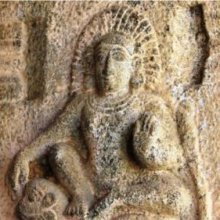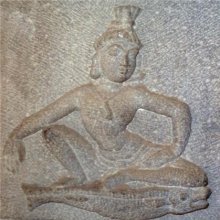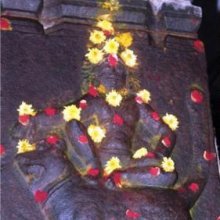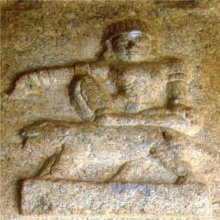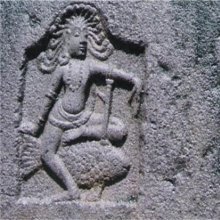Dandahasta, Daṇḍahasta, Daṇḍahastā, Danda-hasta: 14 definitions
Introduction:
Dandahasta means something in Hinduism, Sanskrit. If you want to know the exact meaning, history, etymology or English translation of this term then check out the descriptions on this page. Add your comment or reference to a book if you want to contribute to this summary article.
Images (photo gallery)
(+22 more images available)
In Hinduism
Shilpashastra (iconography)
Source: Google Books: Elements of Hindu iconographyDaṇḍahasta (दण्डहस्त) and gajahasta are terms which have mislead scholars, some of whom have understood them to mean a hand that carries a staff. Literally, the word daṇḍahasta may have such a meaning, but in Sanskrit iconogaraphic works, it is used to denote the arm and hand thrown forwards and held straight like a stick or like the trunk of an elephant.
Source: Shodhganga: The significance of the mūla-beras (śilpa)Daṇḍahasta (दण्डहस्त) or simply Daṇḍa refers to “rod, dangling” and represents one of the four Elirkai gestures, as defined according to texts dealing with śilpa (arts and crafs), known as śilpaśāstras.—Accordingly, pratimā-lakṣaṇa (body postures of the icons) is comprised of hand gestures (hasta, mudrā or kai-amaiti), stances/poses (āsanas) and inflexions of the body (bhaṅgas). There are thirty-two types of hands [viz., daṇḍahasta] classified into two major groups known as tolirkai (functional and expressive gestures) and elirkai (graceful posture of the hand).
(Description of Daṇḍa-hasta): When the gaja-hasta is held in front of the body, it is known as daṇḍa-hasta.

Shilpashastra (शिल्पशास्त्र, śilpaśāstra) represents the ancient Indian science (shastra) of creative arts (shilpa) such as sculpture, iconography and painting. Closely related to Vastushastra (architecture), they often share the same literature.
Natyashastra (theatrics and dramaturgy)
Source: Wisdom Library: Nāṭya-śāstraDaṇḍahasta (दण्डहस्त) refers to one of the five characteristics of the hand (upahasta) according to the Nāṭyaśāstra chapter 33. Accordingly, “when one taking with strikes by the right hand after beginning the stroke with the left hand, the serial strokes are called Daṇḍahasta”.
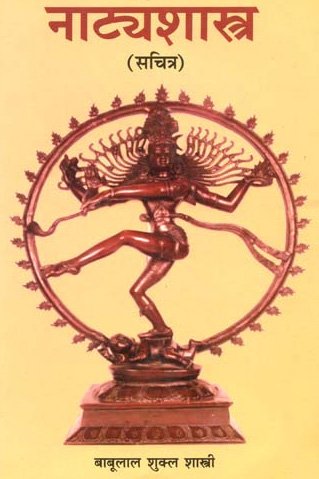
Natyashastra (नाट्यशास्त्र, nāṭyaśāstra) refers to both the ancient Indian tradition (shastra) of performing arts, (natya—theatrics, drama, dance, music), as well as the name of a Sanskrit work dealing with these subjects. It also teaches the rules for composing Dramatic plays (nataka), construction and performance of Theater, and Poetic works (kavya).
Purana and Itihasa (epic history)
Source: archive.org: Shiva Purana - English TranslationDaṇḍahasta (दण्डहस्त) refers to “one holding the staff of punishment in the hand” and is used to describe Śiva, according to the Śivapurāṇa 2.4.12 (“The story of Śiva and Pārvatī”).—Accordingly, as the Gods eulogized Śiva: “[...] Obeisance to the lord free from attachment; obeisance to Śiva the great soul. Obeisance to the pure beyond the world of matter, obeisance to the great, the unwasting. Obeisance to you the god of death holding the staff of punishment (daṇḍahasta) and noose in the hand. Obeisance to the chief of the deities invoked by Vedic mantras. Obeisance to you the hundred-tongued deity. [...]”.
Source: JatLand: List of Mahabharata people and placesDaṇḍahasta (दण्डहस्त) refers to the name of a Weapon mentioned in the Mahābhārata (cf. IX.44.105). Note: The Mahābhārata (mentioning Daṇḍahasta) is a Sanskrit epic poem consisting of 100,000 ślokas (metrical verses) and is over 2000 years old.

The Purana (पुराण, purāṇas) refers to Sanskrit literature preserving ancient India’s vast cultural history, including historical legends, religious ceremonies, various arts and sciences. The eighteen mahapuranas total over 400,000 shlokas (metrical couplets) and date to at least several centuries BCE.
Shaivism (Shaiva philosophy)
Source: SOAS University of London: Protective Rites in the Netra Tantra1) Daṇḍahastā (दण्डहस्ता) refers to “she who holds a stick in her hand” and is used to describe the Devīs associated with Tumburu, according to the Netratantra of Kṣemarāja: a Śaiva text from the 9th century in which Śiva (Bhairava) teaches Pārvatī topics such as metaphysics, cosmology, and soteriology.—Accordingly, [verse 11.1-24ab, while describing the appearance and worship of Tumburu]—“[...] The Devīs are white, red, yellow, and black, four-faced, four armed, three eyed, and in [their] hands bear golden hatchets, sticks and rosaries (daṇḍahastā—daṇḍākṣasūtrahastā ca). [...] Mounted on a corpse, Jayā devī shines forth [in white]; four-armed, four-faced, three-eyed, red Vijayā holds grass, a bow, a shield and a sword, [while] standing upon an owl, O Devī. [...] [When one] worships and meditates on [the Devīs, as they] stand in the cardinal directions, [the Devīs grant the practitioner] the fruits of siddhi. [...]”.
2) Daṇḍahasta (दण्डहस्त) or “holding a stick” is also used to describe Brahmā.—Accordingly, [verse 13.29-36, while describing the appearance and worship of Rudra]—“The auspicious Brahmā [has] four faces, four arms, beautiful eyes, and a red complexion. [He holds] a bundle of very sharp grass [that] hangs down [from his hands]. [Brahmā is] mounted on Haṃsa, holds a stick and Rudrākṣa (daṇḍahasta—daṇḍākṣasūtrahastaḥ), carries a water jar for protection, [and] the four Vedas. [He] gives the fruits of all siddhis”.

Shaiva (शैव, śaiva) or Shaivism (śaivism) represents a tradition of Hinduism worshiping Shiva as the supreme being. Closely related to Shaktism, Shaiva literature includes a range of scriptures, including Tantras, while the root of this tradition may be traced back to the ancient Vedas.
Languages of India and abroad
Sanskrit dictionary
Source: DDSA: The practical Sanskrit-English dictionaryDaṇḍahasta (दण्डहस्त).—
1) a door-keeper, warder, porter.
2) an epithet of Yama.
Derivable forms: daṇḍahastaḥ (दण्डहस्तः).
Daṇḍahasta is a Sanskrit compound consisting of the terms daṇḍa and hasta (हस्त).
Source: Cologne Digital Sanskrit Dictionaries: Shabda-Sagara Sanskrit-English DictionaryDaṇḍahasta (दण्डहस्त).—m.
(-staḥ) 1. A staff-bearer. 2. A door-keeper. n.
(-staṃ) A tree, (Tabernæmontana coronaria.) E. daṇḍa, and hasta the hand.
Source: Cologne Digital Sanskrit Dictionaries: Benfey Sanskrit-English DictionaryDaṇḍahasta (दण्डहस्त).—I. adj. bearing a staff, Mahābhārata 6, 4959. Ii. m. 1. a staffbearer. 2. a door-keeper. Dhanus
Daṇḍahasta is a Sanskrit compound consisting of the terms daṇḍa and hasta (हस्त).
Source: Cologne Digital Sanskrit Dictionaries: Cappeller Sanskrit-English DictionaryDaṇḍahasta (दण्डहस्त).—[adjective] = daṇḍapāṇi adj.
Source: Cologne Digital Sanskrit Dictionaries: Monier-Williams Sanskrit-English Dictionary1) Daṇḍahasta (दण्डहस्त):—[=daṇḍa-hasta] [from daṇḍa] mfn. staff-handed, [Mahābhārata vi, 4959] (Yama)
2) [v.s. ...] m. a doorkeeper, [Horace H. Wilson]
3) [v.s. ...] n. = -mātaṅga, [cf. Lexicographers, esp. such as amarasiṃha, halāyudha, hemacandra, etc.]
4) [v.s. ...] f(ā, ī). (ā, [cf. Lexicographers, esp. such as amarasiṃha, halāyudha, hemacandra, etc.]; ī, [Bhāvaprakāśa v, 2, 29]) idem
Source: Cologne Digital Sanskrit Dictionaries: Yates Sanskrit-English DictionaryDaṇḍahasta (दण्डहस्त):—[daṇḍa-hasta] (staḥ) 1. m. A staff-bearer; door-keeper. n. Name of a tree.
[Sanskrit to German]
Sanskrit, also spelled संस्कृतम् (saṃskṛtam), is an ancient language of India commonly seen as the grandmother of the Indo-European language family (even English!). Closely allied with Prakrit and Pali, Sanskrit is more exhaustive in both grammar and terms and has the most extensive collection of literature in the world, greatly surpassing its sister-languages Greek and Latin.
See also (Relevant definitions)
Relevant text
Search found 10 books and stories containing Dandahasta, Daṇḍahasta, Daṇḍahastā, Danda-hasta, Daṇḍa-hasta, Daṇḍa-hastā; (plurals include: Dandahastas, Daṇḍahastas, Daṇḍahastās, hastas, hastās). You can also click to the full overview containing English textual excerpts. Below are direct links for the most relevant articles:
Rudra-Shiva concept (Study) (by Maumita Bhattacharjee)
1. Rudra-Śiva In The Āraṇyaka Literature < [Chapter 4 - Rudra-Śiva in the Post-Brāhmaṇic Literature]
List of Mahabharata people and places (by Laxman Burdak)
Sittannavasal Frescoes-III < [January-February 1931]
Theatre-Architecture in Ancient India < [July-August 1933]
Theatre Architecture in Ancient India < [October – December, 1998]
Early Chola Temples (by S. R. Balasubrahmanyam)
Bronze, group 2: Age of Aditya I (a.d. 871-907) < [Chapter XI - Sculpture]
The Agni Purana (by N. Gangadharan)
The Skanda Purana (by G. V. Tagare)
Chapter 45 - The Arrival of Sixty-four Yoginīs < [Section 1 - Pūrvārdha]
